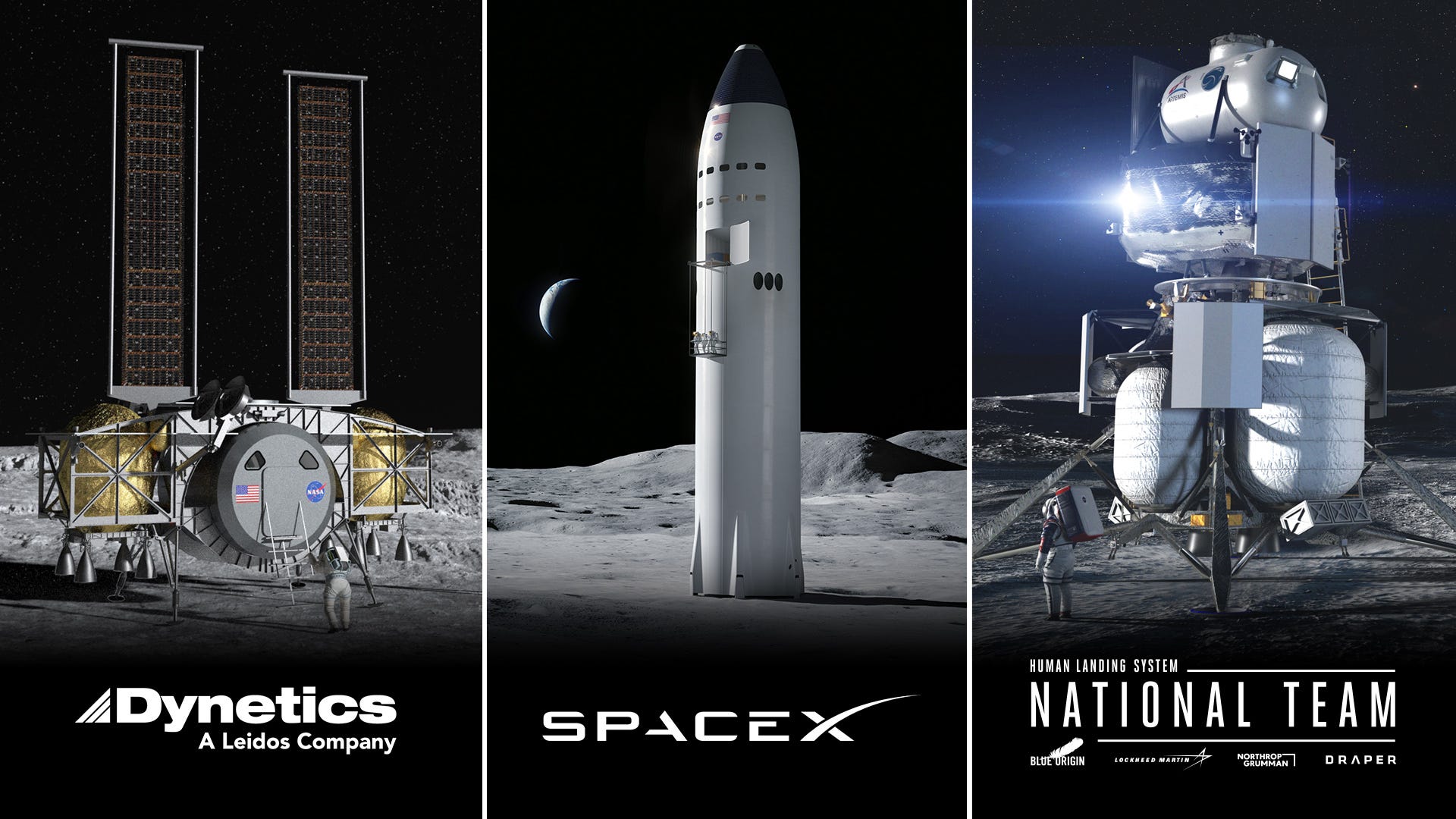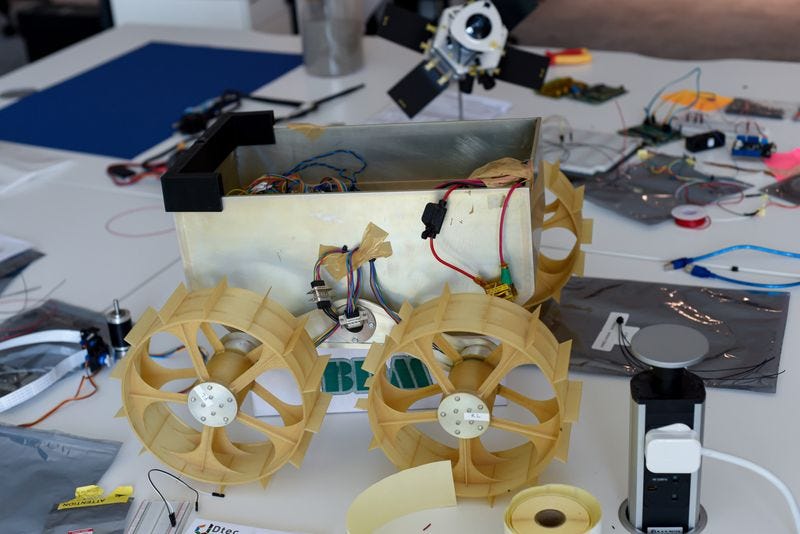Moon Monday Issue #25
Drama around NASA selecting SpaceX Starship for historic mission, UAE builds Moon rover prototype, 3D shapes of Apollo 11 lunar dust, initial radar results from ISRO's Chandrayaan 2 orbiter, and more.
Highlight
Blue Origin and Dynetics both have filed rather lengthy protests against NASA with the Government Accountability Office for selecting only SpaceX to land humans on the Moon for Artemis program’s first surface mission. Both companies argue that NASA has wrongly assessed their designs while overlooking the risks in Starship’s architecture, and is creating a monopoly which will hinder development of other landers.

Blue Origin said to SpaceNews that “NASA has executed a flawed acquisition for the Human Landing System program and moved the goalposts at the last minute. In NASA’s own words, it has made a ‘high risk’ selection.” Blue Origin argues that it wasn’t given the opportunity to revise its bid when NASA concluded that the funding available wouldn’t allow selecting two bidders.
Dynetics’ protest (redacted copy obtained by SpaceNews) says NASA should have revised its approach or withdrawn the solicitation itself once it was clear they couldn’t fund two companies. Dynetics notes that several attributes of its lander that NASA had rated a “significant strength” during the base period HLS award last year were now rated only to be a “strength” now despite not having changed.
In light of these protests, NASA spokesperson Monica Witt said on April 30, “NASA instructed SpaceX that progress on the HLS contract has been suspended until the Government Accountability Office resolves all outstanding litigation related to this procurement.” The said office has 100 days to determine if the protests have merit, and if so, what to do about them. This shouldn’t hinder any near-term development of Starship, the program, as the Lunar Starship is only a variant of it, and we’re still relatively early into the rocket’s development.
Meanwhile, NASA released a request for information (RFI) on April 28 asking companies for feedback on a future Lunar Exploration Transportation Services (LETS) contract to routinely transport astronauts to and from the Moon. This new contract, when solicited, will be open to all U.S. companies and not just the 3 teams in the original bid.
Exploration
After completing a 1400-kilometer sea journey, the core stage of NASA’s SLS rocket has reached the agency’s Kennedy Space Center from the agency’s Stennis Space Center, where it was being tested since early 2020. With the core stage’s arrival, all the elements of the Artemis I mission are at Kennedy––including the upper stage, Orion capsule, and the twin boosters––to assemble and prepare for launch. NASA is still officially sticking to a launch later this year though early 2022 seems more likely.
Intuitive Machines’ first Moon landing mission has been delayed to early 2022 instead of late 2021. A company spokesperson Josh Marshall said, “SpaceX informed Intuitive Machines that due to unique mission requirements, the earliest available flight opportunity is in the first quarter of 2022.”
UAE will perform qualification tests on a prototype of its 10-kilogram Rashid Moon rover between June and July at an unnamed facility outside the country. Once the tests are successful, the team will develop the flight rover, which is currently scheduled for a 2022 launch onboard Japanese company ispace’s maiden Moon landing mission. In an exclusive interview with Gulf News, mission project manager Dr Hamad Al Marzooqi talks about how the Moon fits into their growing space exploration endeavors. It was nice to see him mention and consider the Global Exploration Roadmap. :)

Israeli startup Helios says it has developed a scalable technology to produce oxygen from lunar soil. They have received (an unknown amount of) funding from the Israeli Space Agency and the Israeli Energy Ministry to develop and launch a system on two (as yet unrevealed) space missions over the next three years, the first of which is expected by the end of 2022.
Science
Researchers from the National Institute of Standards and Technology have measured exact 3D shapes of 25 nano-sized lunar dust particles from Apollo 11 samples for the first time. They are analyzing exactly how lunar dust scatters light, and found that the color of light absorbed by particles is greatly affected by their shape despite having same sizes and compositions. The team will analyze more lunar samples next, and the light scattering models they develop will help us better model the Moon’s observed reflective properties.

Initial results from ISRO Chandrayaan 2 orbiter’s dual-frequency radar are out, showing the instrument to be working as expected. It’s the first fully polarimetric synthetic aperture radar sent to the Moon, the first outside Earth orbit in fact. Because of its greater depth penetration, and ability to distinguish between fresh water ice and regolith-mixed ‘dirty ice’, it will help clear the nature of water ice in permanently shadowed regions on the Moon’s poles. The same ability will also help us better understand the physical properties of the rest of the Moon’s varied geological features including lava plains, impact craters, volcanic deposits, buried features, etc.
More Moon
Apollo 11 astronaut Michael Collins, who got the world in his window and had a moving speech to fit from lunar orbit, passed away on April 28.
A pressing article by the New York Times on how only 33 of the about 1600 named Moon craters honor women. The piece’s call for public support is even more fitting when we consider the historical role of women in naming craters on the Moon and beyond.
Thank you Open Lunar Foundation for supporting me and powering this edition of Moon Monday.
Everyone, I’m publishing this one-of-a-kind Moon exploration newsletter for free, with no ads. And it will stay that way. If you like my work, support me to keep it going. Monthly supporters will be credited in future Moon Monday issues with a link to their website/social.
